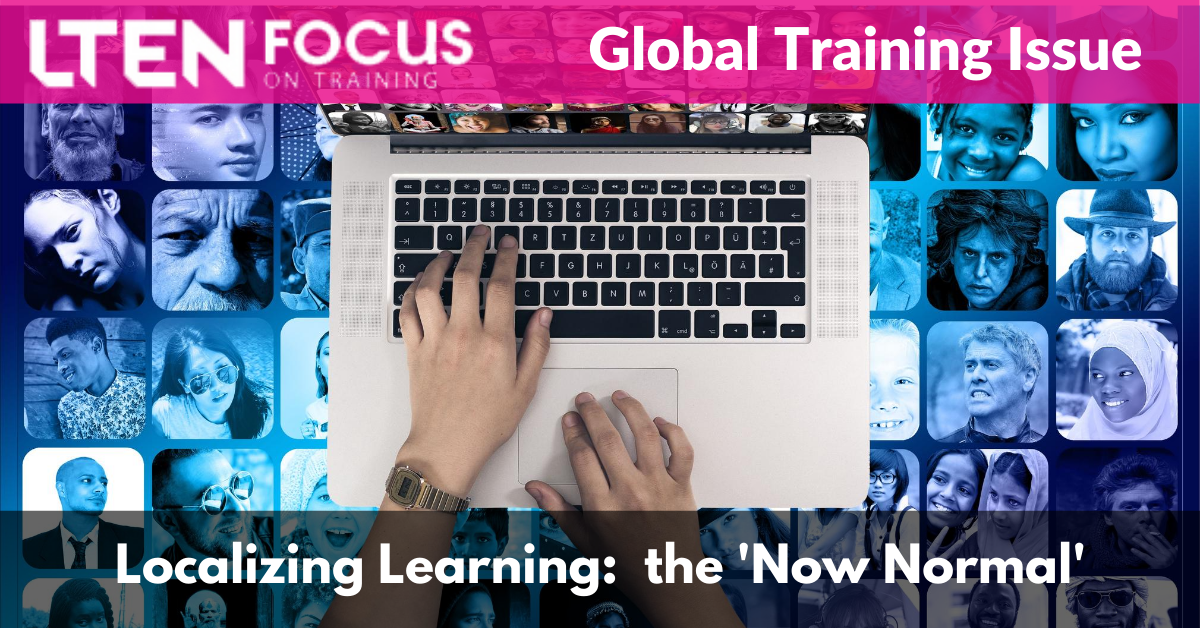
Localizing Learning: The ‘Now Normal’
GUEST EDITOR – Timothy Kingsford
How can we achieve success with so many competing requirements?
In this age of rapid training content development and virtualization driven by tight budgets and diminishing corporate resources, large global organizations struggle to repurpose local training content for global audiences. Adding to this challenge are obstacles like offices scattered across a diverse global infrastructure, content needing to be deployed in many languages, cultural differences, ensuring diversity and inclusion, and divergent regulatory requirements.
Designing a single solution usually results in long development cycles, inadequate detail at the local level and awkward learner experiences. Selecting and implementing standardized tools and processes and sharing information among learning content designers are key.
 How can we achieve success in today’s environment with so many competing requirements and perspectives?
How can we achieve success in today’s environment with so many competing requirements and perspectives?
Baxter Healthcare has done this by implementing innovative and often revolutionary learning design and delivery to share high-quality content from locality to locality. Maturing some of our corporate culture norms also contributed to our efforts. Finally, COVID-19 and its impact on every part of the business was the impetus for speeding up a long-standing, slowly developing transition from the old learning culture to a headlong rush to the new.
Clear Definition
To begin, we clearly defined our area of influence and limited exposure to distractions from other areas of our organization. For example, we focused only on commercial training and avoided any conflicts with quality or HR initiatives. While these efforts may be equally important, they are more diverse, more broadly distributed and heavily constrained by the one-size-fits-all model. By designing and deploying only commercial content, we minimized the overhead of multiple approval processes, longer review times and larger subject-matter-expert groups that are often affiliated with those broader initiatives.
We then defined four simple but critical factors of success:
- Standardized rapid development tools used across the organization.
- A cooperative global community of instructional content owners.
- Common deployment platforms.
- A concerted effort to minimize bureaucracy.
The combination of each of these factors and our learning cultural shift allowed us to confront and overcome the obstacles traditionally plaguing efforts to move content to broader audiences.
Shrinking Silos
Over the past few years, we have transitioned from a very distributed learning environment to one with corporate standards replacing many differing silos. Specifically, we are well into the process of standardizing our learning tools, including:
- Articulate 360 as our rapid development suite.
- Cornerstone On-Demand as our learning management system.
- Skillsoft as our “off-the-shelf” provider.
- Allego as our video coaching and mobile engagement/sales enablement platform.
Some solutions are now only partially implemented. But all are standardized for global use, and all had at least one beta project underway when COVID-19 struck.
Global Discussions
At about this same time, our information technology organization started rolling out corporate-wide social exchange functionality. This allowed us to have public and private discussions, regardless of home country.
Discussion groups began popping up, covering learning, content development and instructional design. Our learning groups are now sharing current events in ways rarely seen before. And individual experiences — both positive and negative — are openly discussed.
These conversations have formed a cooperative global community with shared interests where the differences between localities can be recognized and embraced more quickly. It also has the added advantage of being an early warning system for learning professionals. We’re able to see what may be headed our way, talk directly to the content creators and proactively prepare for changes for our individual business regions.
 The combination of the new tool and the new learning culture are driving new, automated processes. The early warnings from the global user community allow us to better anticipate likely regulatory challenges and respond preemptively. We’ve started to minimize bureaucracy by reducing rework, communication loops and approval challenges. Rather than having to navigate multiple diverse systems and processes, our newly standardized resources have helped us produce, test and deploy customized learning content for specific localities with a speed, simplicity and collaboration not seen in our previous learning ecosystem.
The combination of the new tool and the new learning culture are driving new, automated processes. The early warnings from the global user community allow us to better anticipate likely regulatory challenges and respond preemptively. We’ve started to minimize bureaucracy by reducing rework, communication loops and approval challenges. Rather than having to navigate multiple diverse systems and processes, our newly standardized resources have helped us produce, test and deploy customized learning content for specific localities with a speed, simplicity and collaboration not seen in our previous learning ecosystem.
Successful Sharing
To date, our response to COVID-19 for our commercial teams demonstrates our biggest success. U.S.-developed content was created so that learning professionals could access it during development and influence its direction for deployment in their locales, even prior to translation.
Because our global commercial teams use the same deployment platform, they also can access the Americas content. And, since our global learning teams share the same rapid development tools, they can modify source files and release customized content for their learners and locales without starting over or commissioning third-party developers. They avoid the contracting delays, development cycle times and all the related overhead.
By using our standard rapid development tools, we can quickly create new, extension modules that empower our commercial teams to be more effective in response to COVID-19 challenges. The Americas learning team, too, has benefited by learning from our global learning partner via the new social channels and team discussion resources.
Conclusion
We haven’t achieved perfection, but we have made significant strides in our ability to take content created for specific, limited audiences and repurpose it for diverse audiences with similar needs. Our learning culture change, shared resources and desire to meet the demands of our adult learners and business partners has improved exponentially from where we were just a few short years ago.
Many organizations have struggled for years to change. COVID-19 has created a situation that is now driving that change. The media has called this new era the “New Normal,” but we like to call it the “Now Normal.”
What we’ve been trying to achieve has been around for a long time in global learning ecosystems, but our own cultural bias, rigid practices and natural instincts for status quo have limited our success. Finally, we can deploy capabilities to modernize ourselves for the Now Normal.
Timothy Kingsford is senior manager, learning innovation & ops, for Baxter Healthcare. Email him at timothy_kingsford@baxter.com.








